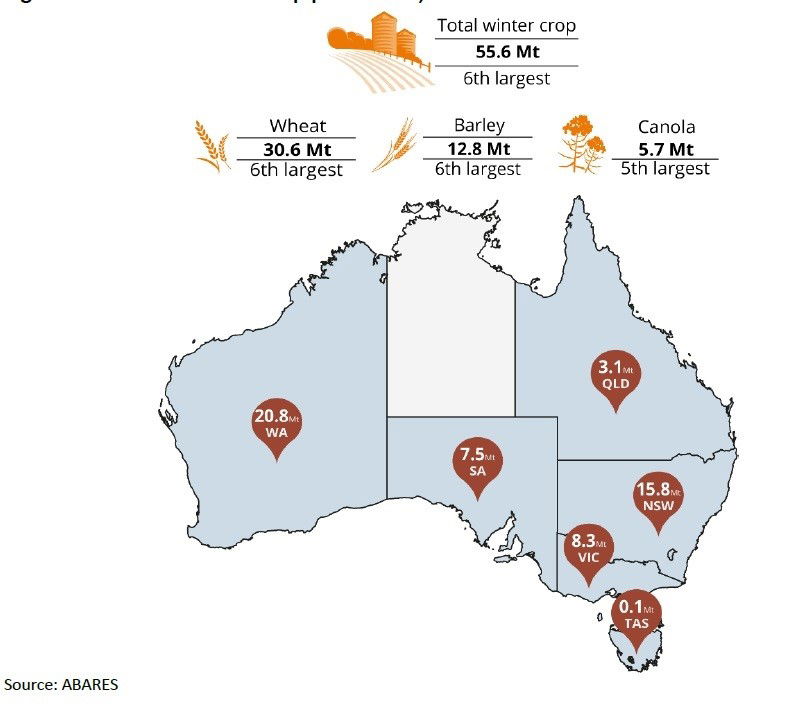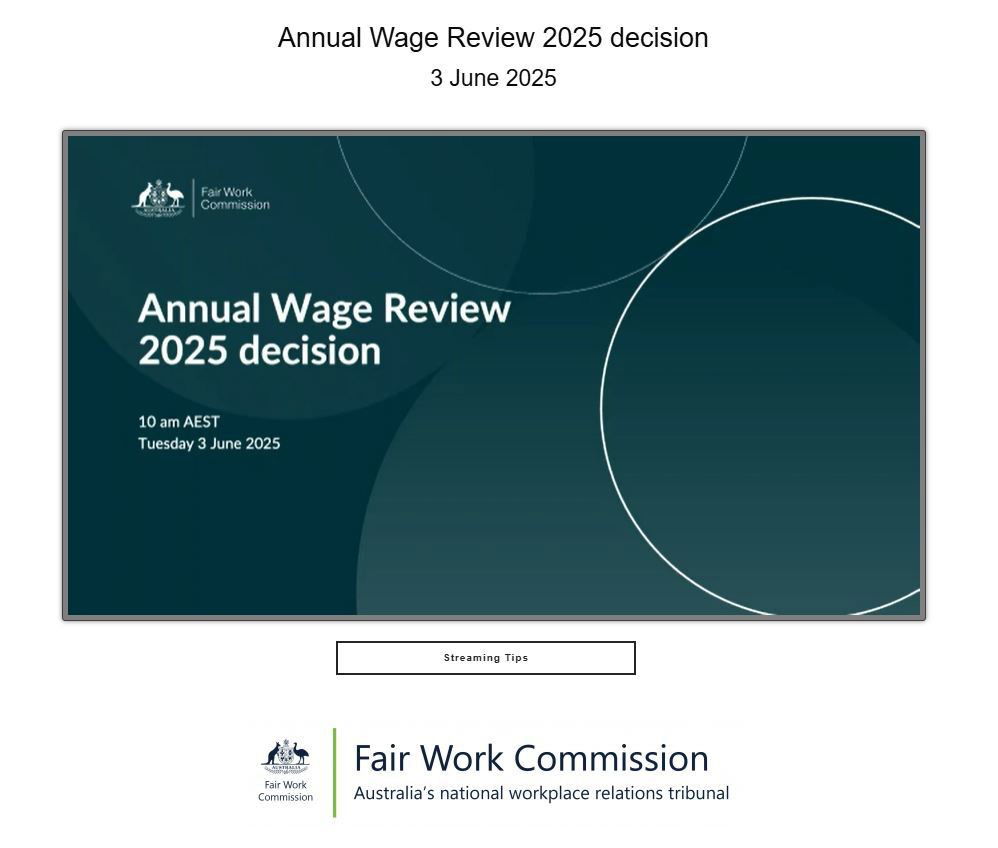Market snapshot
- ASX 200 futures: +0.9% to 8,506 points
- Australian dollar: +1% at 64.95 US cents
- Dow Jones : +0.1% to 42,305 points
- S&P 500: +0.4% to 5,935 points
- Nasdaq: +0.7% to 19,242 points
- FTSE: flat at 8,774 points
- EuroStoxx 50: -0.5% to 5,355 points
- Spot gold: +2.8% to $US3,832/ounce
- Brent crude: +3.8% to $US65.21/barrel
- Iron ore: -0.4% to $US95.98/tonne
- Bitcoin: -0.8% to $US104,843
Prices current around 6:45am AEST.
Live updates on the major ASX indices:
Drought weighs on grain production estimates
As drought stretches across south-eastern Australia, the June ABARES crop report is reflecting the decision by many grain growers there to scale back their seeding programs.
But ABARES says growers in WA, southern Queensland and northern NSW have made up the difference, ultimately leaving the planted area at 24.9m hectares, the second highest on record.
Based on the current winter forecast, national winter grain production is estimated to drop 8% off last year, to 55.6 million tonnes.
Nationally, wheat, barley, canola, and chickpea production are tipped to fall, while lentil plantings and production estimates are up.

The tricky balance of dealing with / not provoking… inflation
As noted earlier, the decision is a shift from previous ones – in that it acknowledges people need to ‘catch up’ on living standards eroded by inflation.
Here’s what the President said, from the report.
“The continuation of this inflationary episode has meant that, over the last three annual wage review decisions, the Commission has repeatedly deferred taking any action to reverse this ongoing decline in real wages out of a concern that this might result in the further persistence of higher inflation.
“The result has been that living standards for employees dependent on modern award wages have been squeezed and the low paid have experienced greater difficulty in meeting their everyday needs.
“The Reserve Bank of Australia’s (RBA) assessment that inflation has sustainably returned to its target range of 2–3 per cent indicates that this inflationary episode is now over.
“That provides us with an opportunity to go at least some of the way towards correcting what has happened over the last four years by awarding a real increase to modern award wages and the national minimum wage (NMW).
“We are concerned that if this opportunity is not taken in this Review, the loss in the real value of wages which has occurred will become permanently embedded in the modern award system and the NMW and a reduction in living standards for the lowest paid in the community will thereby be entrenched.”
Read the full decision here
The Annual Wage Review is at this link, in full detail.
We’ll have reaction and analysis on the blog and the ABC News site all day.
What the national minimum wage rise means for you
What does it mean?
The minimum wage is going up, by 3.5%
Soon, the national minimum wage will be $948.00 per week or $24.95 per hour.
The commission’s decision increases the national minimum wage to about $24.95 per hour or just under $948 per week, based on a full-time, 38-hour working week.
When does it kick in?
The order will operate from July 1, 2025, and will take effect in relation to a particular employee from the start of the employee’s first full pay period on or after July 1, 2025.
Lower interest rates and hot demand to push property prices
House prices growth has moderated as interest rates bit into people’s ability to borrow.
But now?
Nassim Khadem looks at new projections of where property prices are heading.
Loading…
Award and minimum wages to out-pace inflation
With the inflation dragon seemingly slayed (if we ignore the world trade shattering tariff turmoil) the Fair Work Commission has bumped minimum and award wages by more than the price that goods and services are rising by.
So workers will be ahead, right?
Not quite.
The FWC president noted that over the past three annual minimum decisions they declined to deal with the erosion of living standards by inflation because they were worried that they would be stoking it if they lifted the “floor” of wages.
There was an acknowledgement that the overall trend — and those specific decisions — meant people were going backwards.
They are now dealing with it “by awarding a real increase to modern wages and the minimum wage”.
Although many in the business community were worried about higher wages, the FWC assessed that “if this opportunity is not taken … the loss [of living standards would] become permanently embedded” in the lives of Australians.
Again, while there is a substantial proportion of people who are paid the minimum wage what it does is help set the level of higher wages as well.
With that in mind, the president was clear — it’s time for workers to start making back some of what they’ve lost in the past few years.
“We are satisfied the level of wage increase is sustainable.”
To summarise: minimum wage up 3.5%
The minimum wage will increase by 3.5 per cent from July 1, following the Fair Work commission’s annual review of the minimum wage and award agreements.
Around a fifth of Australian workers are paid according to award wages.
The minimum wage and awards increased by 3.75 per cent last year, after higher inflation pushed real wage growth further down in comparison.
Inflation is currently at 2.4 per cent annually.
Gender equality another factor in the bump
Justice Adam Hatcher, president of the Fair Work Commission, says the commission will shortly take on a substantial look at gender equality across different role classifications (jobs and sectors) which is likely to feed into next year’s result.
They’ve adjourned, so let the analysis begin!
Poor productivity a ‘restraining factor’ in holding back wage rises
In the market sector there has been “modest growth” over the business cycle, enabling business to pay more.
Non-market sectors (government, care etc) haven’t seen the same growth.
Also taken into account:
- Superannuation guarantee going up
- US tariff uncertainty
- Softness in accommodation / tourism market
Minimum wage rises to combat what’s been eroded by inflation
Minimum wages will LIFT 3.5% from July 1, 2025.
“[Workers] have suffered a reduction in the real value of their wage rates,” Justice Hatcher says.
The FWC president says over the past three annual decisions they declined to deal with the erosion of living standards by inflation.
They are now dealing with it …
“… by awarding a real increase to modern wages and the minimum …
“If this opportunity is not taken … the loss will become permanently embedded.
“We are satisfied the level of wage increase is sustainable.”
3.5% EFFECTIVE 1 JULY 2025
It’s not just the economy
The factors considered include:
- Gender equality
- Social inclusion
- Workforce participation
20.7% of Australian workers get the minimum wage
“Principally affected by.. this decision,” says Justice Adam Hatcher, President of the Fair Work Commission.
They are more likely to be:
Grab a coffee, join me at the desk
Want to watch the results of the Annual Wage Review?
You can.
Go to the link and join me. Or just wait for our team to summarise it.
They normally read out a lot of the detail before the actual ‘number’.

Trading about to kick off, here’s what happened yesterday
Before we get going today, here’s the take from Kyle Rodda of Capital.com about yesterday’s trading period and what we can look forward to.
- Wall Street continues to brush off simmering trade risks
- US data reveals impact of tariffs on manufacturing activity
- Gold prices break-out and eye re-rest of all time highs
“The markets keep shrugging off simmering trade war risks.
“Despite the doubling of aluminium and steel tariffs and some spicy rhetoric by the US and China about trade relations, Wall Street erased an early loss to end the session broadly higher. The gains were largely driven by US tech stocks and the Magnificent Seven names in particular. While it has slipped down the list of priorities for market participants, below trade policy, fiscal policy and macroeconomic data, a very solid set of quarterly results from mega cap tech is enticing investors into the market. There also remains, more than likely, some degree of complacency, too.
“The so-called “TACO” trade has reached peak memetic value; market participants are resting their hopes that Trump won’t push things far enough to hurt the economy or markets.
“The data flow painted a mixed picture of the US fundamental outlook. The ISM Survey was the first major data release for the week, which all builds up the Non-Farm Payrolls figures on Friday, revealing an unexpected drop. Tariffs were the word for respondents in the survey, with their imposition impacting everything from new orders, inventories and everything in between. Fortunately for market participants, the prices paid index, while still elevated, did rise as much as expected, keeping those worries of a stagflationary US economy at bay for the time being.
“Gold prices remain the best expression of trade war risks, with prices breaking out overnight and renewing their uptrend. Although the so-called “AI” and “TACO” trades respectively are supporting the equity market, gold continues to reflect the cyclical and secular impacts of US trade policy, with a weaker US Dollar also sending a similar signal. The break higher suggests a possible retest of previous highs as upward momentum picks. A daily close and some consolidation above $3400 would hint at a building push to another record high.”
Will China’s EV price war lead to cheapers cars in Australia?
The editor of “The Driven”, Giles Parkinson, says these price discounts may be passed on to Australian consumers, but to a much lesser extent than we’re seeing in China, and they’ll take a while.
Loading…
The minimum wage for the coming year will be revealed shortly
WHO’S minimum wage decision????
– Steve
Good question Steve.
An Expert Panel of the Fair Work Commission reviews and sets minimum wages for employees in the national system each year.
“The Fair Work Act 2009 sets out the objectives of the review. The process includes research, submissions and consultations.”
As the FWC notes:
“As part of the review, the President of the Commission may direct the Panel to investigate and report on certain matters. It must publish all research so the public can make submissions on the issues it covers.
“The President or the Panel also set an Annual wage review research program each year. A Minimum Wages Research Group endorses the research. The chair of the group is from our Economic Analysis Team. This team carries out or requests the research.
Other members of the group are representatives nominated by:
- the Australian Chamber of Commerce and Industry
- the Australian Industry Group
- the Australian Council of Social Service
- the Australian Council of Trade Unions
- the Australian Government
- state and territory governments.
ICYMI: Monday’s video finance report
Did you miss Alan Kohler’s finance report last night? Don’t stress, we’ve got you. The numbers refer to yesterday’s data, so catch up on where we’ve been, to get a steer on where you’re going today.
What’s UP with the Aussie dollar?
Going to be a lot of interest in the +1% spike in the value of the Australian dollar against the US, as at the last time I checked Eikon.
Here’s the word from CommBank’s Kristina Clifton, senior economist and senior currency strategist:
“AUD/USD rose by around 0.6% overnight and is trading just below 0.6500. Broad based USD weakness and a lift in US equities supported AUD/USD.
“AUD/USD may drop today if the minutes from the Reserve Bank of Australia’s (RBA) prior policy meeting in May are dovish given the global economic backdrop (11.30am Sydney time). Markets will focus on the weight of argument behind each of the on hold, 25bp cut, and 50bp cut options that were considered.
“The last of the partial economic data, net exports and government spending, is also released today ahead of tomorrow’s Q1 25 GDP (same time)
“USD fell against all the major currencies that we track overnight, except for CNH. Renewed trade tensions between China and the US were a headwind for the USD.
“The US ISM manufacturing index was also weaker than expected at 48.5pts, (49.5pts expected). The impacts of the tariffs are seen in the prices paid component which remained elevated at 69.4pts.
“Tonight’s highlight will be the JOLTS job openings data (midnight Sydney time). The consensus of US economists is for a modest decline in job openings to 7,100,000 in April.
“We judge that its probably too early for US tariff policy to weigh on payrolls given the long period of low unemployment would make employers reluctant to cut staff. However tariff policy will likely make employers reluctant to hire new staff, which will be reflected in lower job openings.”











